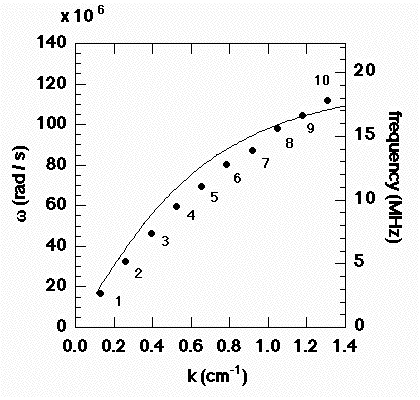Nonlinear electrostatic wave
in non-neutral electron plasma
Dispersion relation for the linear electrostatic waves (Trivelpiece-Gould mode)
The measured linear dispersion relation of Langmuir waves in a confined nonneutral electron plasma with a cylindrical boundary is shown below. In this case, the plasma density on the axis ne~ 6.9 x 10^6 cm^{-3} (N ~ 4 x 10^8) and the plasma temperature Te ~ 0.2 eV give the Debye length ~ 0.13cm and the electron plasma frequency of 23.5MHz. The number for each measured point denotes its mode number l. Here, the Trivelpiece-Gould dispersion relation is suitable for the present plasma. It is seen that the oscillation frequency is proportional to k when k is small as a rough approximation. The solid line in the figure is calculated from the Trivelpiece-Gould dispersion relation with the effective plasma density n_{eff} ~ 5.0 x 10^6 cm^{-3}.

FFT spectrum of a decay instability
A typical behavior of a large amplitude Langmuir wave whose initial power is beyond the threshold is shown in figures. Hereafter, the Langmuir wave of mode l is represented by Ll. In these figures, the large amplitude (-23.6 dBm detected at the electrode No.4) L4 is excited with the center electrode by applying the RF perturbation of 9.5 MHz during 4 microsec. The plasma parameters are the same as before. Shown in the figure below are the time sequence of FFT power spectra of the signal detected at the electrode No.4.

Temporal evolution of the wave power
In the figure below, the power of the main three peaks (l = 1,3,4) are plotted as functions of time. It can be seen that only the excited L4 dominates the oscillation of the plasma and it decays exponentially until 70 microsec. Then L1 and L3 begin to grow exponentially from the noise level (< -50 dBm) to the level of initially excited wave (-35 dBm) until 90 microsec. On the other hand, the decay rate of L4 changes suddenly at 90 microsec and heavily decays from -30 dBm to -47 dBm until 100 microsec. As a result, L4 decays and L1 and L3 are created through this process. This is thought to be the decay instability among Langmuir waves.

As already mentioned, these decay processes have thresholds for the power of the initially excited wave. It is found that the threshold depends on the plasma temperature. The obtained results show that the threshold becomes lower as the plasma temperature becomes higher.
Reference
Hiroyuki Higaki, Plasma Phys. Control. Fusion 39 (1997) 1793-1803
Back to the top